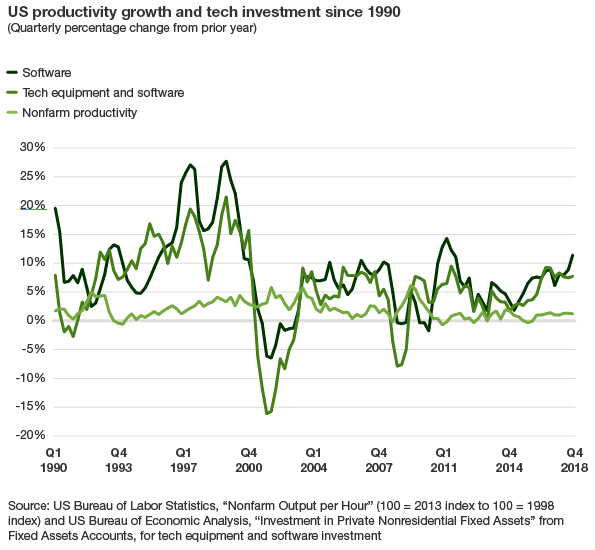Your Technology Investments May Not Deliver The Productivity Gains You Expected

Improving productivity has traditionally been a key justification for technology investments. However, trends in overall US productivity indicate that increases in tech spending no longer raise overall US productivity as much as in the past. Given that US firms have theoretically been investing heavily in digital transformation, the failure of overall US productivity to grow impugns the notion that tech investments will continue to deliver productivity gains at the macro level — and potentially at individual firms. Thus, CIOs should rethink how to reposition their value proposition for tech spending away from improved productivity.
Forrester’s report, “The Shrinking Productivity Gains From Technology Investments,” explains why US productivity growth has stagnated across virtually all industries despite increases in tech spending. While individual tech investments can still be justified on productivity gains, the report recommends that CIOs start building their business cases for tech spending on effectiveness gains (the increased probability of good business outcomes and the reduced probability of bad business outcomes). To elucidate this point, the report examines the following key observations:
-
-
- Since 2010, US productivity growth has plateaued at roughly 1%. Given the positive relationship between increasing national productivity and economic growth without inflation, every company should be concerned about stagnating or declining productivity. Since technology has historically played a key role in productivity improvement, the impact of tech spending on productivity must be considered.
- During this time, tech investment growth averaged 5%. Since productivity growth generally lags tech investment growth, we would expect to see productivity growth increase by now as a result of tech investments made throughout the past decade. It is foreboding that, instead, US productivity growth over the past decade has averaged 1% when tech investment grew at an average of 5% (the quarterly rates were 3-9% from 2010 to 2012, 4% from 2013 to 2016, and 7-9% from 2017 to 2018).
- The correlation between tech investment and increasing productivity has deteriorated, suggesting the need for alternative tech spending justifications. Given that US productivity growth no longer seems responsive to increases in tech spending, CIOs must seek alternative tech spending justifications. Forrester recommends focusing on improving business effectiveness instead—increase the probability of good business outcomes and mitigate the probability of bad ones.
- Our analysis reveals that at the industry level, the relationship between tech investment growth and productivity has been negative since 2012. When we trended productivity growth over the past decade across all industries, our analysis showed that increased tech spending is associated with worse productivity growth (see report <link> for chart). This observation further underscores need for alternative tech spending justifications and should foreworn CIOs that they might be held responsible or criticized if their firm experienced decreased productivity within the past decade.
- CIOs who continue to justify tech investments largely on increased productivity risk jeopardizing their own credibility. As the effects of stagnating productivity become more evident, CIOs will be called into question. To prepare for this scrutiny, CIOs must justify and defend tech spending through alternative validations such as business effectiveness.
-
For more information and recommendations, check out the report or schedule an inquiry.
